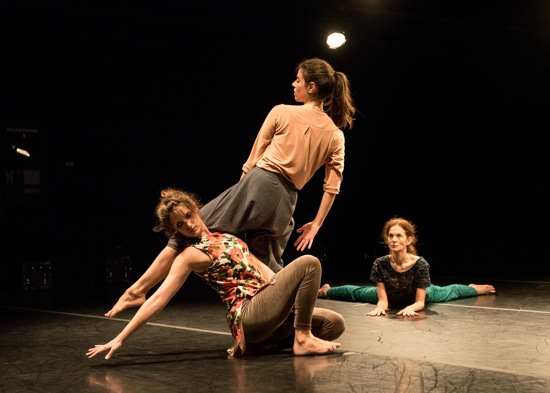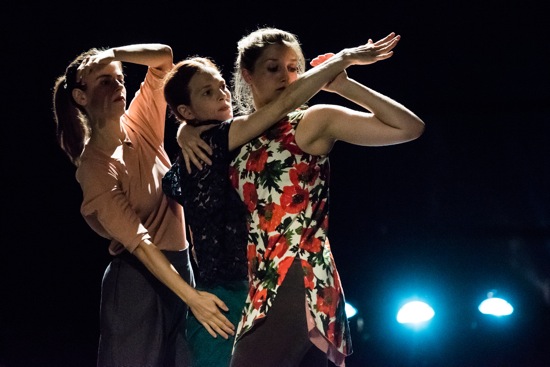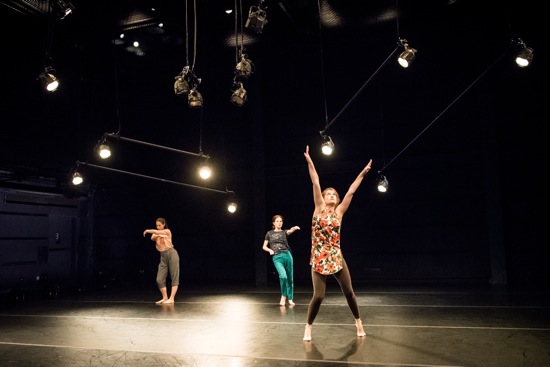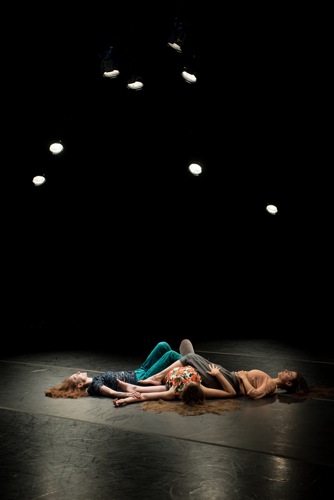Jodi Melnick presents a trio, Moment Marigold, at BAM Fisher.

Jodi Melnick’s Moment Marigold: Emmagrace Skove-Eppes on floor, left, with Maggie Thom. Melnick at right. Photo: Ian Douglas
When is a theme not a theme? When is a person not a persona? Jodi Melnick raises these questions in a brief program essay about her new Moment Marigold. She also noted that she begins the choreographic process by working in a studio by herself, letting movement ideas emerge. Creating this work, which premiered at BAM Fisher, she had company in the studio, Maggie Thom and Emmagrace Skove-Epes, and the result is a thoughtful study in interdependency and cooperation among three women.
Melnick is an amazing dancer—not one who goes for big effects, but one who draws beautifully nuanced movements out of herself and trains them in intricacy, the way you might help a morning glory vine to climb up your house. By that simile, I don’t mean she espaliers dancing into a strict design, but rather enhances its wildness by helping it to take its desired paths.
There’s something quietly sensual about her dancing. No part of the seen body is unexplored—hips, hands, arms, shoulders, neck, elbows, knees, hands, fingers. Currents flowing through one activate another. Smooth, rippling gestures mate with small, sharp ones.

(L to R): Maggie Thom, Jodi Melnick,and Emmagrace Skove-Eppes in Melnick’s Moment Marigold. Photo: Ian Douglas
Marigolds layer petals in increasingly large concentric circles. Their finished shape is contained, but small, ruffled variations crop up within it. One of the first things that the three women do is to cluster together and—as if testing a process—lay their hands on one another and twist within that closeness into a variety of shapes, bewitching in their complexity. It’s as if the three are forming one knot after another. When they’ve finished that to their satisfaction, they sit on the floor and then lie back, still holding hands—partially untying what they have made.
Their environment, viewed by the audience sitting on two sides of the Fishman Space, is dominated by the lighting instruments that master designer Joe Levasseur has rigged up.
Most of the bell-shaped lamps (I counted around 20) are hung in pairs, one at either end of a horizontal or tilted pipe. A few hang straight from the ropes. Those in tandem are clustered loosely at different heights and aimed in various directions. I can’t imagine the work in a less intimate setting; it’s too elegantly focused on subtleties for that.
The music, by Steven Reker, often falls silent. You may hear a deep, sustained tone, then higher ones, maybe a series of clacking sounds. Sometimes the music persists in a repeating rhythmic pattern; sometimes partially buried voices speak or an a cappella choir sings in harmony. The women wear clothes by Reid Batrthelme and Harriet Taub that give them the ease of movement that practice clothes would, but the outfits also blend the mundane with the unusual or fanciful.
Melnick, Thom, and Skove-Eppes walk matter-of-factly into various parts of the space—separately, calmly, and persistently dancing, occasionally directing their gazes upward. They settle from counterpoint into unison when you least expect it. They come together for other arm games. One of these involves one performer laying her arms—straight and parallel to each other—across another’s similarly positioned ones. In principal, the design echoes the position you make with the crisscrossed index and third fingers of both your hands, preparatory to teasing your first-grade friend with “Put your finger in the crow’s nest; the crow’s not home.” Except that assembled and disassembled lattices in Moment Marigold are bigger and squarer and catch nothing.

L to R: Maggie Thom, Jodi Melnick, and Emmagrace Skove-Eppes beneath Joe Levasseur’s lights. Photo: Ian Douglas
In one curious episode, Thom and Skove-Eppes sit and watch Melnick take up a sharp knife with blade that’s approximately eight inches long. She doesn’t wield it ominously, but flashes it around, strokes it along her fingers, and flicks an invisible bit of something off it. There’s something borderline playful about her attitude to the weapon. In any case, she puts it away and rejoins the others,
I understand the distinction that Melnick is making between motifs that provide a thematic structure and movement ideas that are repeated in order to blossom in new directions. In her program essay, she also remarks that “The experience of the performer drives the work without it being about the persona. I question if that’s possible.” So do I (assuming I know exactly what she means). Without playing a role or directing dancing at the spectators with an eye to entertainment or virtual seduction, performers nevertheless perform themselves-as-dancers. Like Yvonne Rainer several decades ago, Melnick cannot hide her charisma, try as she might.
What I think often happens in Moment Marigold is that the performers, especially Thom and Skove-Epes seem to be trying to downplay their personas. But, since they are vital and gifted beings, who must be interested in and excited by the fine things they are doing, suppressing those feelings doesn’t render them neutral; it only makes them look dutiful, almost, at times. sulky.
Toward the end of the piece, the lights, which have been subtly changeable, get very bright, andthe women take down their hair—Melnick first loosening Skove-Epes’s, then her own. The three lie down, their legs overlapping, and their bodies and heads raying away from the center, their hair spread out around their heads. They resemble a triad of art Pre-Raphaelite Ophelias. Or a strangely beautiful Marigold Moment.

